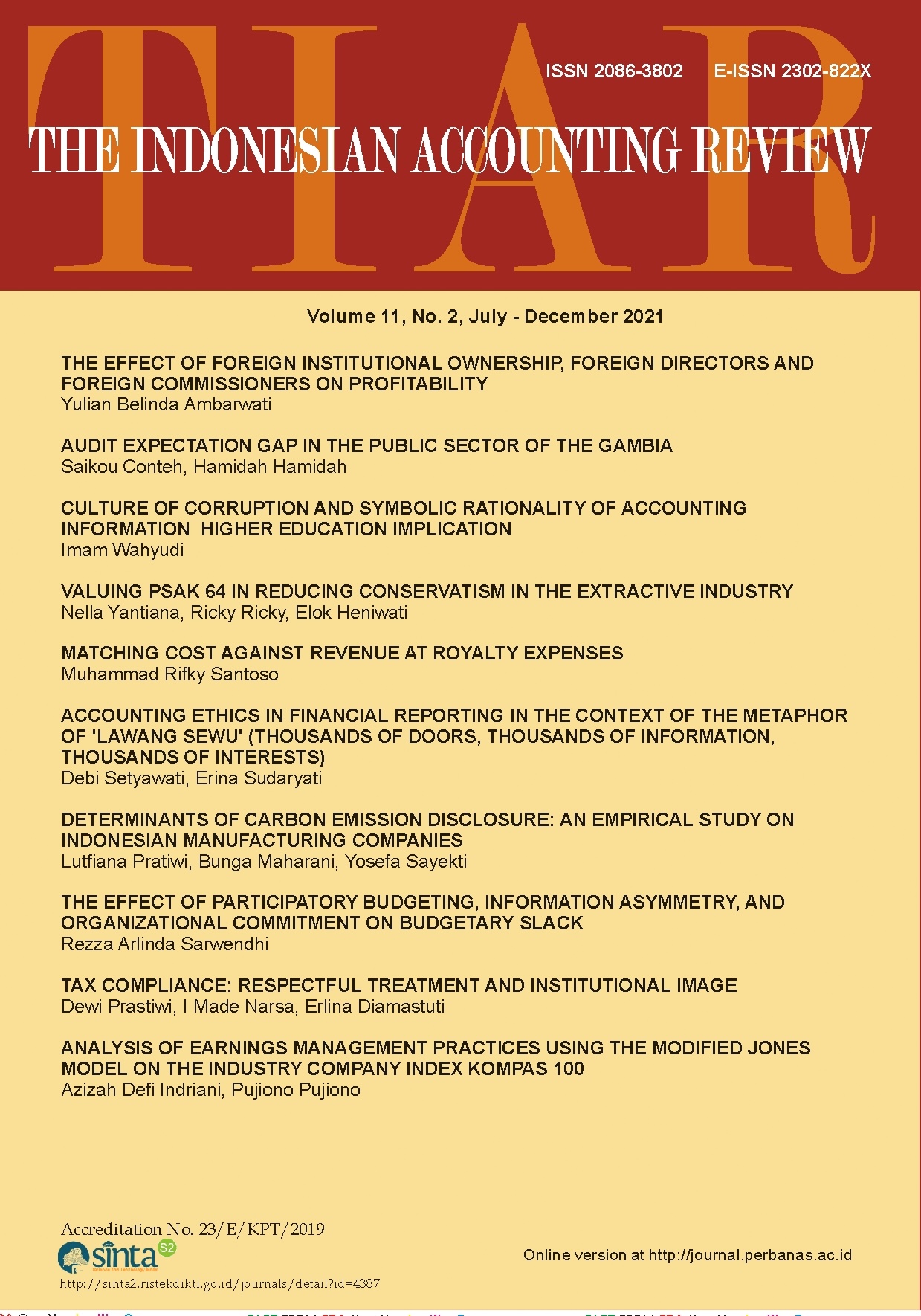Analysis of Earnings Management Practices Using the Modified Jones Model on the Industry Company Index Kompas 100
DOI:
https://doi.org/10.14414/tiar.v11i2.2383Keywords:
earnings management, discretionary accruals, modified Jones modelAbstract
This study aimed to examine the issue of differences in earnings management patterns in companies listed on the Indonesia Stock Exchange (IDX). Earnings management can occur because company management wants to take advantage of accounting descriptions/policies under the character of the assets, existing in each of these industries. This study used a Modified Jones Model approach in determining earnings management proxies. Besides, it also used analysis of variance (ANOVA) to test whether there were differences in earnings management patterns. The data were consisted of 450 companies from 8 industrial sectors in the Kompas 100 Stock Index during 2015-2019. They were from various industries; essential and chemical industry; consumer goods; services; mining, oil, natural gas; plantation; property and real estate; and banking. The result shows that there are differences in earnings management patterns between industrial sectors. Therefore,  company management practices earnings management following the characteristics of each industry. The research also suggests that the next study should analyze the comparison of earnings management with other models to determine the consistency of results.
References
Abdurrahim, Ahim. (2015). Mendeteksi Earnings Management. Jurnal Akuntansi & Investasi, 1(2), 104-111.
Accounting Principles Board. (1970). APB Statement No.4 Basic Concepts Accounting Principles Under-lying Financial Statement of Business Enterprises. AICPA
Belkaoui, A. Riahi. (2006). Teori Akuntansi. Jakarta: Salemba Empat, Buku 1, 388 hlm.
Belkaoui, A. Riahi (2007). Teori Akuntansi. Jakarta: Salemba Empat, Buku 2, 334 hlm.
DeAngelo, L. E. (1986). Accounting Number as Val-uation Substitutes: A Study of Management Buyouts of Public Stockholders. The Account-ing Review, 59: 400-420.
Dechow, PM, and Sloan, R. (1991). Executive Incen-tives and The Horizon Problem: An Empirical Investigation. Journal of Accounting and Econom-ics, 14, 51-89.
Dechow, PM., Sloan, R. G., & Sweeney, A. P (1995). Detecting Earnings Management. Source: The Accounting Review.
Dechow, PM, Sloan, RG, Sweeney, AP (2012). Detect-ing Earnings Management. American Account-ing Association, 70 (2), 193-225.
Healy, P. M. (1985). The Effect of Bonus Schemes on Accounting Decisions. Journal of Accounting and Economics, 10: 85-107.
Jensen, M., & Meckling, W. (1976). Theory of The Firm: Managerial Behavior, Agency Costs, and Ownership Structure. Journal of Financial Eco-nomics, 3 (4), 305-360.
Jones, J. J. (1991). Earnings Management During Im-port Relief Investigations. Journal of Account-ing Research, 29 (2): 193-228.
Sari, R. A. (2012). Pengaruh Karakteristik Perus-ahaan Terhadap Corporate Social Responsibil-ity Disclosure Pada Perusahaan Manufaktur yang Terdaftar di Bursa Efek Indonesia. Jurnal Nominal, I, 124-140.
Scott, William R. (2015). Financial Accounting Theo-ry (5th ed). Pearson Prentice Hall
Siallagan, Hamonangan. (2009). Pengaruh Mana-jemen Laba (Earnings Management) Terhadap Nilai Perusahaan. Jurnal Ekonomi Bisnis dan Akuntansi, 2(1), 61-70.
Sulistiyanto, Sri. (2008). Manajemen Laba (Teori dan Model Empiris). Grasindo.
Watts, RL, & Zimmerman, J.L (1990). Positive Ac-counting Theory: A Ten Year Perspective. The Accounting Review, 65 (1), 131-156.
Wikipedia.org. Compass Index 100. (https://id.wikipedia.org/wiki/Indeks_Kompas100. Accessed on 4 June 2018)
Downloads
Submitted
Published
How to Cite
Issue
Section
License
Copyright (c) 2021 The Indonesian Accounting Review

This work is licensed under a Creative Commons Attribution-NonCommercial 4.0 International License.


















